We had some difficulty this year finding time
for our holidays. We finally had to take a few weeks off in October
and decided to visit Cost Rica.
The trip unfortuneatly turned out to be a big waste of time and
money. Several tropical storms (Wilma, Stan and Beta) in the Carribean
sent a continuous flow of very wet clouds over the area from Venezuela
up to mid Mexico. This resulted in more or less continuous heavy
rain for all except about three days of our trip. On many days it
was simply not possible to do anything more sensible than hang around
the hotel bar (which was sometimes fun, but not really was why we
came here).
Costa Rica is a country of extreme natural beauty, and it is very
easy to travel there. Unlike all the other countries in the Americas
we have been so far, almost everyone speaks English in Costa Rica.
My (very modest) knowledge of Spanish made some things easier, but
we were very grateful every time we met someone we could speak English
to. That way i was even able to fight off a ticket for speeding,
it was a long, long discussion in partly Spanish, partly English.
I really esteemed the friendly and factual atmosphere those police
men maintained. I'd like to see more of this in my own country.
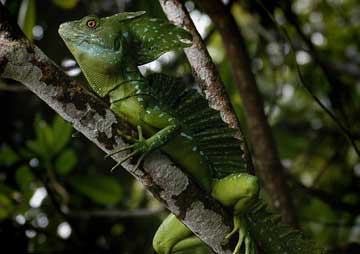 For this trip, we had planned to follow the standard tourist routes
from San Jose across the mountains, taking the Volcan Poas route,
to La Fortuna to see Volcan Arenal in action at night. Here we were
lucky, it was one of the cloudless nights and seeing a volcano spitting
out lava is truly spectacular. From La Fortuna we drove around the
Laguna Arenal and up the bumpy gravel road to the Monte Verde reserve.
We were glad we had a four wheel driven car, but on the other hand,
compared to the roads we had met in Patagonia on our former trip,
this one was a bit bumpy but otherwise safe. Monte Verde Area unfortuneately
looks more or less like Disneyland today, so we recommend to not
go there at all, or, if you must, go for a few of days only.
For this trip, we had planned to follow the standard tourist routes
from San Jose across the mountains, taking the Volcan Poas route,
to La Fortuna to see Volcan Arenal in action at night. Here we were
lucky, it was one of the cloudless nights and seeing a volcano spitting
out lava is truly spectacular. From La Fortuna we drove around the
Laguna Arenal and up the bumpy gravel road to the Monte Verde reserve.
We were glad we had a four wheel driven car, but on the other hand,
compared to the roads we had met in Patagonia on our former trip,
this one was a bit bumpy but otherwise safe. Monte Verde Area unfortuneately
looks more or less like Disneyland today, so we recommend to not
go there at all, or, if you must, go for a few of days only.
From Monte Verde, we then tried (unsuccessfully, due to a flooded
bridge) to go to the Rincon de la Vieja park. After a night in a
lodge on the 'good' side of the bridge, we tried again, bridge was
still under water, so we continued down the Pacific coast towards
Tarcoles, to see the Carara park there. But this part of our trip
is not worth mentioning at all.
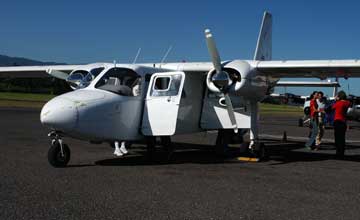 Some
rainy days later, with no pictures worth showing, we returned to
San Jose and went on to the Carribean coast, to the Tortuguero reserve,
We had good weather on the way out tere, and good weather on the
way back. The days in between were rain, nothing but rain. This
made it nearly impossible to see any animals, and more or less confined
us to the bar. We flew back to San Jose in this very special 8 seater
plane, and then back home (glad to finally get out of this more
or less flooded area).
Some
rainy days later, with no pictures worth showing, we returned to
San Jose and went on to the Carribean coast, to the Tortuguero reserve,
We had good weather on the way out tere, and good weather on the
way back. The days in between were rain, nothing but rain. This
made it nearly impossible to see any animals, and more or less confined
us to the bar. We flew back to San Jose in this very special 8 seater
plane, and then back home (glad to finally get out of this more
or less flooded area).
 We will go to Costa Rica again some time, we think it is well worth
it. But we will go during the dry season next time, and we recommend
strongly to avoid going there during the hurricane season (September
thru mid November) and also recommend to avoid the tourist tracks
completely, it is simplly too touristy there by now, hardly any
of the famous places location is really worth your time. We will
go, on our next trip, to the Corcovado park on the Peninsula de
Osa in southeast, and maybe to the Pacific coast of the Peninsula
de Nicoya in the northwest only, and spend all time there. This
seems at least currently in 2005, to be the only place to escape
the crowd.
We will go to Costa Rica again some time, we think it is well worth
it. But we will go during the dry season next time, and we recommend
strongly to avoid going there during the hurricane season (September
thru mid November) and also recommend to avoid the tourist tracks
completely, it is simplly too touristy there by now, hardly any
of the famous places location is really worth your time. We will
go, on our next trip, to the Corcovado park on the Peninsula de
Osa in southeast, and maybe to the Pacific coast of the Peninsula
de Nicoya in the northwest only, and spend all time there. This
seems at least currently in 2005, to be the only place to escape
the crowd.
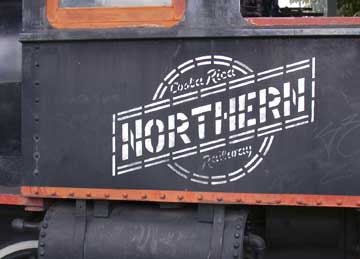 At San Jose, we got to see some railroad action of what is left
from the two Costa Rica railroad companies, the FCalP and the FCA,
one running from San Jose to Puntarenas on the coast of the Pacific,
the other running north to Limon on the coast of the Atlantic. One
tour operator runs weekend trips from San Jose to the Pacific port
of Puntarenas on weekends.
At San Jose, we got to see some railroad action of what is left
from the two Costa Rica railroad companies, the FCalP and the FCA,
one running from San Jose to Puntarenas on the coast of the Pacific,
the other running north to Limon on the coast of the Atlantic. One
tour operator runs weekend trips from San Jose to the Pacific port
of Puntarenas on weekends.
The Atlantico station is nowadays part of a school of arts, and
some cars and locomotives are rebuilt to be rooms where children
can draw and paint. We were there for a whole morning, and thought
that the museum idea is just brilliant, but wish that a part of
the station remain a real railroad station.
More astonishing is the new use of the San Jose area part of the
line for some mourning commuter trains in both directions. The trains
are usually accompanied by a police partrol in the city center because
the line is built right in the middle of the street.
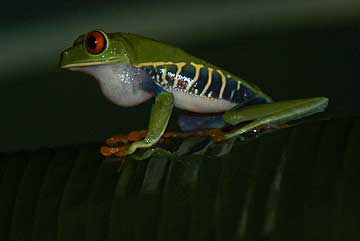 We had some difficulty this year finding time
for our holidays. We finally had to take a few weeks off in October
and decided to visit Cost Rica.
We had some difficulty this year finding time
for our holidays. We finally had to take a few weeks off in October
and decided to visit Cost Rica.
 For this trip, we had planned to follow the standard tourist routes
from San Jose across the mountains, taking the Volcan Poas route,
to La Fortuna to see Volcan Arenal in action at night. Here we were
lucky, it was one of the cloudless nights and seeing a volcano spitting
out lava is truly spectacular. From La Fortuna we drove around the
Laguna Arenal and up the bumpy gravel road to the Monte Verde reserve.
We were glad we had a four wheel driven car, but on the other hand,
compared to the roads we had met in Patagonia on our former trip,
this one was a bit bumpy but otherwise safe. Monte Verde Area unfortuneately
looks more or less like Disneyland today, so we recommend to not
go there at all, or, if you must, go for a few of days only.
For this trip, we had planned to follow the standard tourist routes
from San Jose across the mountains, taking the Volcan Poas route,
to La Fortuna to see Volcan Arenal in action at night. Here we were
lucky, it was one of the cloudless nights and seeing a volcano spitting
out lava is truly spectacular. From La Fortuna we drove around the
Laguna Arenal and up the bumpy gravel road to the Monte Verde reserve.
We were glad we had a four wheel driven car, but on the other hand,
compared to the roads we had met in Patagonia on our former trip,
this one was a bit bumpy but otherwise safe. Monte Verde Area unfortuneately
looks more or less like Disneyland today, so we recommend to not
go there at all, or, if you must, go for a few of days only.  Some
rainy days later, with no pictures worth showing, we returned to
San Jose and went on to the Carribean coast, to the Tortuguero reserve,
We had good weather on the way out tere, and good weather on the
way back. The days in between were rain, nothing but rain. This
made it nearly impossible to see any animals, and more or less confined
us to the bar. We flew back to San Jose in this very special 8 seater
plane, and then back home (glad to finally get out of this more
or less flooded area).
Some
rainy days later, with no pictures worth showing, we returned to
San Jose and went on to the Carribean coast, to the Tortuguero reserve,
We had good weather on the way out tere, and good weather on the
way back. The days in between were rain, nothing but rain. This
made it nearly impossible to see any animals, and more or less confined
us to the bar. We flew back to San Jose in this very special 8 seater
plane, and then back home (glad to finally get out of this more
or less flooded area).
 We will go to Costa Rica again some time, we think it is well worth
it. But we will go during the dry season next time, and we recommend
strongly to avoid going there during the hurricane season (September
thru mid November) and also recommend to avoid the tourist tracks
completely, it is simplly too touristy there by now, hardly any
of the famous places location is really worth your time. We will
go, on our next trip, to the Corcovado park on the Peninsula de
Osa in southeast, and maybe to the Pacific coast of the Peninsula
de Nicoya in the northwest only, and spend all time there. This
seems at least currently in 2005, to be the only place to escape
the crowd.
We will go to Costa Rica again some time, we think it is well worth
it. But we will go during the dry season next time, and we recommend
strongly to avoid going there during the hurricane season (September
thru mid November) and also recommend to avoid the tourist tracks
completely, it is simplly too touristy there by now, hardly any
of the famous places location is really worth your time. We will
go, on our next trip, to the Corcovado park on the Peninsula de
Osa in southeast, and maybe to the Pacific coast of the Peninsula
de Nicoya in the northwest only, and spend all time there. This
seems at least currently in 2005, to be the only place to escape
the crowd.
 At San Jose, we got to see some railroad action of what is left
from the two Costa Rica railroad companies, the FCalP and the FCA,
one running from San Jose to Puntarenas on the coast of the Pacific,
the other running north to Limon on the coast of the Atlantic. One
tour operator runs weekend trips from San Jose to the Pacific port
of Puntarenas on weekends.
At San Jose, we got to see some railroad action of what is left
from the two Costa Rica railroad companies, the FCalP and the FCA,
one running from San Jose to Puntarenas on the coast of the Pacific,
the other running north to Limon on the coast of the Atlantic. One
tour operator runs weekend trips from San Jose to the Pacific port
of Puntarenas on weekends.
 The
beautiful Art Deco style station of the Ferrocarril al Pacifico
is next to the vast workshops, and next to a large park area which
belongs to the railroad station area, and is fenced and guarded.
We asked the guards if we could enter and make photographs, and
got permission to walk anywhere but inside the shops. We were very
pleased (given my poor Spanish), and spent the better part of a
rare sunny afternoon at the station just watching or exchanging
some words with railroad men.
The
beautiful Art Deco style station of the Ferrocarril al Pacifico
is next to the vast workshops, and next to a large park area which
belongs to the railroad station area, and is fenced and guarded.
We asked the guards if we could enter and make photographs, and
got permission to walk anywhere but inside the shops. We were very
pleased (given my poor Spanish), and spent the better part of a
rare sunny afternoon at the station just watching or exchanging
some words with railroad men.
 Three
old locomotives are on display in the park area of the Pacifico
station, two early steamers and one electric. The line to the Pacific
was converted to electric traction in the 30ies.
Three
old locomotives are on display in the park area of the Pacifico
station, two early steamers and one electric. The line to the Pacific
was converted to electric traction in the 30ies.
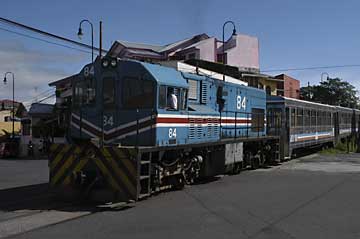 Here
is engine #84 pulling one of the morning commuter trains toward
the Pacifico station, crossing a busy street crossing in the east
of San Jose, between the two main stations in town, assisted by
police on bikes. Our hotel happenend to be just meters away from
this scene, and i ran there quite a few times ...
Here
is engine #84 pulling one of the morning commuter trains toward
the Pacifico station, crossing a busy street crossing in the east
of San Jose, between the two main stations in town, assisted by
police on bikes. Our hotel happenend to be just meters away from
this scene, and i ran there quite a few times ...
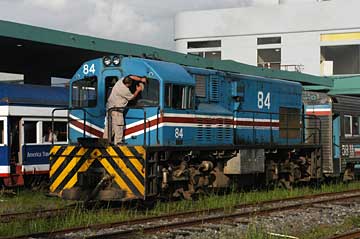 Here
is #84 beeing polished after bringing her train in to the Pacifico
station.
Here
is #84 beeing polished after bringing her train in to the Pacifico
station.